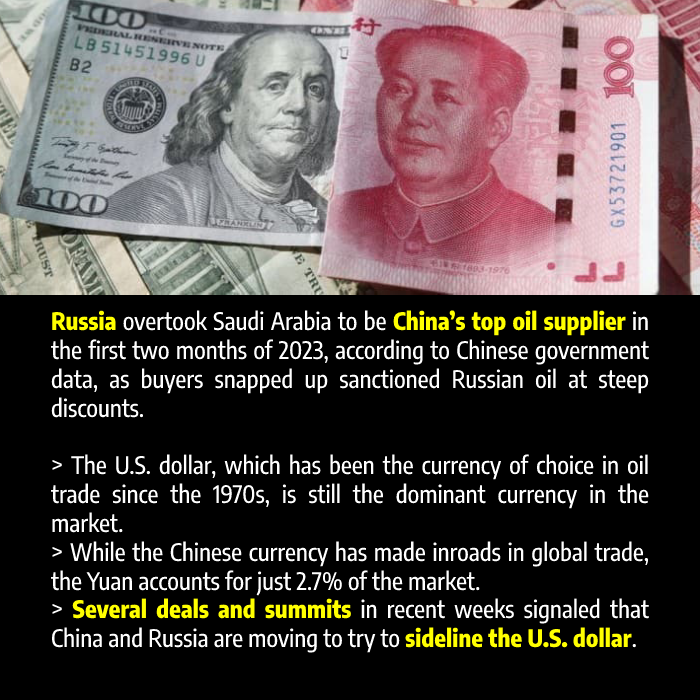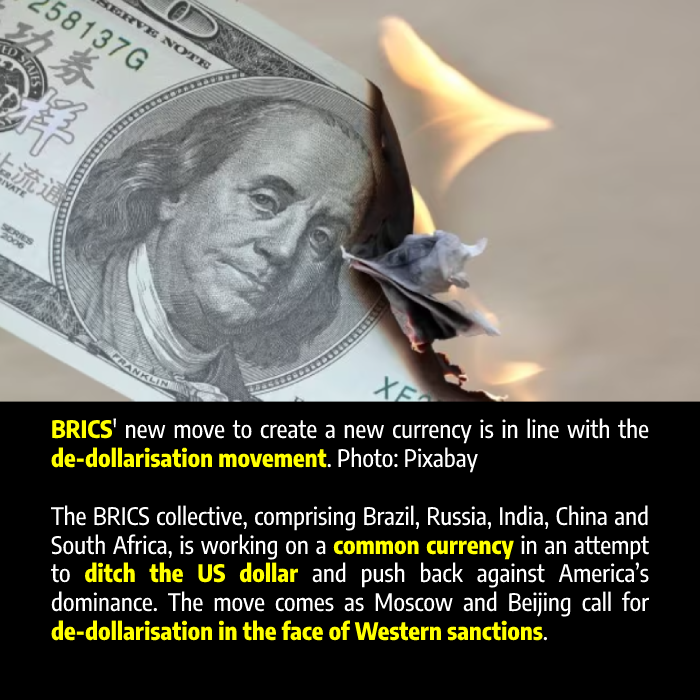
The increasingly closer relations between China and Russia and the Chinese push to make its currency more relevant on the global markets are challenging the dominance of the petrodollar.
The U.S. dollar, which has been the currency of choice in oil trade since the 1970s, is still the dominant currency in the market and global currency reserves. But several recent deals and highest-level summits have sought to undermine the dollar’s dominance.
The new geopolitical alliances, where China and Russia are working to oppose a U.S.-led global order, could undermine the petrodollar.
China has been looking for years to establish more trade deals in yuan to increase the relevance of its currency on the global markets and challenge the U.S. dollar’s dominance in international trade, including in energy trade.
During a landmark visit to Saudi Arabia’s capital Riyadh in December, Chinese President Xi Jinping said that China and the Arab Gulf nations should use the Shanghai Petroleum and National Gas Exchange as a platform to carry out yuan settlement of oil and gas trades.
“China will continue to import large quantities of crude oil from GCC countries, expand imports of liquefied natural gas, strengthen cooperation in upstream oil and gas development, engineering services, storage, transportation and refining, and make full use of the Shanghai Petroleum and National Gas Exchange as a platform to carry out yuan settlement of oil and gas trade,” Xi said in December, as carried by Reuters.
While the Chinese currency has made inroads in global trade, the yuan accounts for just 2.7% of the market, compared to the U.S. dollar’s share of 41%.
Moreover, the U.S. dollar accounted for more than 58% of the global currency reserves as of the end of 2022, compared to a 2.7% share for the Chinese yuan, per data from the International Monetary Fund (IMF).
Several deals and summits in recent weeks signaled that China and Russia are moving to try to sideline the U.S. dollar.
Last month, China’s Xi met with Putin in Moscow, and the Russian president not only endorsed trade in yuan with China but also with other countries.
“We support the use of Chinese yuan in payments between Russia and countries of Asia, Africa, and Latin America,” Putin was quoted as saying by Russian media.
According to Putin, two-thirds of the bilateral trade between China and Russia is already being done in the two national currencies—the yuan and the ruble, respectively.
Over the past year, Russia has turned to trade in yuan in the wake of the Western sanctions on its exports, imports, and energy trade, as the Chinese currency has become Putin’s only alternative to reducing exposure to the U.S. dollar and the euro, and limiting the fallout of the sanctions that have seen Russian state assets seized in Western countries.
Last week, China and Brazil agreed to carry out bilateral trade settlements in their own currencies and dump the U.S. dollar as the intermediary currency, in another move seen as China’s increased efforts to undermine the dollar dominance.
Brazil and China are part of the so-called BRICS alliance of five major emerging economies—Brazil, Russia, India, China, and South Africa.
Also last week, China reportedly completed its first trade of liquefied natural gas (LNG) settled in yuan on the Shanghai Petroleum and Natural Gas Exchange.
Chinese state oil and gas giant CNOOC and TotalEnergies completed the first LNG trade on the exchange with settlement in the Chinese currency, the exchange said in a statement carried by Reuters.
The U.S. dollar hasn’t lost its power in global trade, especially in energy trade, but the growing divide between the U.S. and the West on the one hand, and the China/Russia axis on the other hand, could embolden China to look to further boost the relevance of the yuan in the new world order.
Source: Oilprice.com. 5 April 2023
RELATED:

